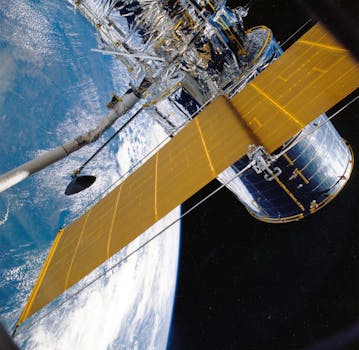
Beyond Earth: How Recent Advances in Satellite Tech are Shaping Global Communications
Satellite Technology
Satellite technology has come a long way since the launch of the first artificial satellite, Sputnik, in 1957. Today, satellites play a crucial role in global communications, navigation, weather forecasting, and space exploration. Recent advances in satellite technology have enabled the development of smaller, more efficient, and cost-effective satellites that can provide high-speed internet connectivity to remote and underserved areas.
The focus keyword Beyond Earth: How Recent Advances in Satellite Tech are Shaping Global Communications is the key to understanding the impact of satellite technology on global communications. With the increasing demand for global connectivity, satellite technology is becoming an essential component of modern communication systems.
One of the significant advantages of satellite technology is its ability to provide coverage in areas where traditional communication infrastructure is lacking. Satellites can beam signals to remote areas, enabling people to access the internet, make phone calls, and send messages. This has opened up new opportunities for businesses, governments, and individuals to connect with each other and access vital information.
The development of low-Earth orbit (LEO) satellites has been a significant breakthrough in recent years. LEO satellites orbit the Earth at an altitude of around 2,000 kilometers, which is much lower than traditional geostationary satellites. This lower altitude enables LEO satellites to provide faster and more reliable connectivity, with lower latency and higher bandwidth.
Companies like SpaceX, Amazon, and OneWeb are launching constellations of LEO satellites to provide global internet coverage. These constellations consist of hundreds or even thousands of satellites that work together to provide seamless connectivity.
Another significant advancement in satellite technology is the development of phased array antennas. These antennas use advanced electronic beamforming technology to steer and shape the satellite’s signal, enabling it to focus on specific areas and provide more targeted coverage.
Phased array antennas have improved the efficiency and capacity of satellites, enabling them to provide higher data rates and more reliable connectivity. This technology has also enabled the development of smaller and more compact satellites, which are easier to launch and maintain.
Global Communications
Global communications have become an essential part of modern life, and satellite technology is playing a vital role in enabling global connectivity. Satellites provide a means of communicating with people in remote and underserved areas, where traditional communication infrastructure is lacking.
The increasing demand for global connectivity has driven the development of new satellite technologies, such as LEO satellites and phased array antennas. These technologies have improved the efficiency and capacity of satellites, enabling them to provide higher data rates and more reliable connectivity.
Satellite technology has also enabled the development of new applications and services, such as satellite-based broadband, satellite-based navigation, and satellite-based earth observation. These applications have transformed the way we communicate, navigate, and understand our planet.
The impact of satellite technology on global communications has been significant, enabling people to connect with each other and access vital information. Satellite technology has also enabled businesses and governments to communicate with each other and with people in remote and underserved areas, facilitating global trade, commerce, and development.
Challenges and Opportunities
Despite the significant advances in satellite technology, there are still several challenges that need to be addressed. One of the major challenges is the issue of space debris, which poses a significant threat to the sustainability of satellite technology.
Space debris consists of old satellites, rocket parts, and other objects that are orbiting the Earth and can collide with operational satellites, causing damage and disrupting global communications. To address this issue, satellite operators and manufacturers are working together to develop sustainable practices and technologies that can mitigate the risk of space debris.
Another challenge facing the satellite industry is the issue of regulatory frameworks. Satellite technology is regulated by a complex array of national and international laws and regulations, which can create uncertainty and barriers to entry for new players.
To address this issue, governments and regulatory agencies are working together to develop more streamlined and effective regulatory frameworks that can facilitate the growth and development of the satellite industry.
Despite these challenges, the future of satellite technology looks bright, with significant opportunities for growth and development. The increasing demand for global connectivity, the development of new technologies, and the expansion of existing applications and services are all driving the growth of the satellite industry.
As satellite technology continues to evolve and improve, we can expect to see new and innovative applications and services emerge, transforming the way we communicate, navigate, and understand our planet.
Conclusion
In conclusion, recent advances in satellite technology are revolutionizing global communications, enabling faster and more reliable connectivity across the globe. The development of LEO satellites, phased array antennas, and other technologies has improved the efficiency and capacity of satellites, enabling them to provide higher data rates and more reliable connectivity.
As the demand for global connectivity continues to grow, satellite technology will play an increasingly important role in enabling global communications. With its ability to provide coverage in remote and underserved areas, satellite technology has the potential to transform the way we communicate, navigate, and understand our planet.
As we look to the future, it is clear that satellite technology will continue to evolve and improve, driving innovation and growth in the satellite industry. With its significant opportunities for growth and development, the future of satellite technology looks bright, and we can expect to see new and innovative applications and services emerge, transforming the way we communicate and interact with each other.






